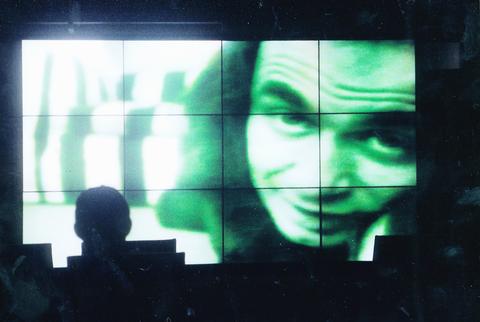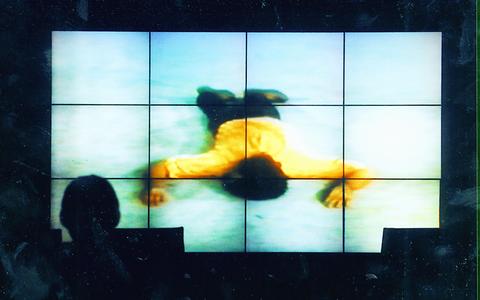Art in the late 20th century has been distinguished by the inclusion of video and television, new media that continue to shape artistic creation.
Hello, Masters!, the current event at the Museum of Contemporary Art in Taipei, offers a retrospective of the major developments in the more than 30 years of the history of electronic moving images in art. Its weekly schedule, like that of a film festival, features the works of nine artists grouped according to six themes.

The use of video as a medium in art began in 1963 with Exposition of Music -- Electronic Television, a milestone exhibition in Wuppertal, Germany. It was the first solo exhibit for Nam June Paik, the Korean-born artist whose opus of installations, videotapes, global television productions, films, and performances reshaped our perceptions of the temporal image in contemporary art.

PHOTO:DAVID VAN DER VEEN, TAIPEI TIMES
Studying music composition, Paik traveled to Germany in 1956 to pursue his interest in avant-garde music. Two years later, he met composer John Cage, whose ideas on composition and performance were a great influence on Paik, as were those of George Maciunas, the founder of the radical art movement Fluxus, which Paik was invited to join.
At the exhibition, Paik scattered about the room several televisions, on their sides and upside down. He placed magnets near the TV sets and rearranged the wires in them to distort their reception of broadcast transmissions. He also created interactive video works that transformed the relationship between viewers the medium.
Throughout the 1970s and 1980s, Paik also worked as a teacher and an activist, supporting other artists and working to realize the potential of the emerging medium. Along with his remarkable sequence of videotapes and projects for television, featuring collaborations with Laurie Anderson, Joseph Beuys, David Bowie, Cage, and Merce Cunningham, he created a series of installations that fundamentally changed video and redefined artistic practice.
The Father of Video Arts, the opening part of "Hello, Masters!" presents three of Paik's most important works.
Video Synthesizer and TV Cello is one of his early experiments with television. Using video synthesizers and scan modulators -- devices Paik developed to manipulate the transistors and resistors of TV sets -- he creates abstract images of waving, swinging and changing colors. Its aim is to reduce TV sets to objects of art.
Paik's legendary installation, TV cello -- a mock cello made of three TV monitors, creates visual music also by manipulating electronic images.
The significance of Global Groove lies in its opening statement: "This is a glimpse of a new world when you will be able to switch on every TV channel in the world and TV guides will be as thick as the Manhattan telephone book." Made in 1973, it anticipates two trends for television: channel zapping and a growing space for music on TV.
Other parts of the series introduce video artists who made ingenious use of the medium in the 1970s and 1980s.
Experimental video pioneers Steina and Woody Vasulka represent the development of the "Machine Vision" concept -- the use of various optical artifices and video camera movements to shoot images of space not perceived by the human eye.
Based in Santa Fe, New Mexico, Icelander Steina Vasulka and Czech Woody Vasulka began building complex machines in 1975 that integrate mirrors, closed-circuit control monitors, fish-eye lenses or prisms to execute panoramas and exagegrated zooms like those found in Urban Landscape.
Landscape plays a vital role in their works. In Summer Salt, Steina fixed a modified camera to the roof or the front bumper of a car travelling through an American desert. The distorted images of the desert show an aerial quality that is at once distant and close, when the reddish earth literally invades the screen.
The Video Linguistics section shows the selected works made in the 1970s by Gary Hill, now famous mainly for his installation works made in the 1990s. Hill uses video to experiment with language, which, for him, is not just as a vector for meaning, but a sound in its own right.
URA ARU (1985) is one of the films that characteristically demonstrates Hill's interest in language games. The two Japanese words mean "back to front" and "existence" respectively. The film plays with visual and acoustic palindromes like that of its title. While palindromes are being spoken, videographic tricks present movements first in a normal way and then being reversed.
The Video Zen section features Bill Viola, who uses poetic images to discuss the human condition, especially birth and death, an interest dating back to the 1970s, when he spent 18 months in Japan studying with painter and zen master Tanaka Daien.
Produced in Japan, Hatsu Yume, or First Dream, shoots the cycle of a single day, Japanese new year. The day goes from fish caught on shore, a man's walk on dark streets, and light reflected on the surface of the water. It is Viola's attempt at dealing with the relationship between light, water and life. "Land means death for fish. Darkness means death for man," he was quoted as saying.
Shaken by consecutive events; the birth of his son and the death of his mother, Viola explores more ontological questions in The Passing. The black-and-white film shows Viola asleep, his subconsciousness taking him to the past and future, in slow motion.
The last section of the series brings viewers to the post-pop art era with the early works of artists Mike Kelley and Paul McCarthy.
Kelley was known to many inside the art world for the cover art of Sonic Youth's 1992 album Dirty. Along with his installation works, his videos often deal with the sexual desire and anti-social complex latent in daily life.
Also working with various media, the 55-year-old McCarthy talks almost exclusively about human degradation, mutilation, scatology and perversion in his works.
Both interested in repressive family structures, the two artists' first collaboration, Family Tyranny, takes up the theme of a family's dirty secrets.
The development of video art, from experimenting, challenging, to integrating the medium into video works' metaphor and structure, goes hand in hand with the development of video technology. The series may not be able to showcase each stage of the development with the best examples, such as the Swiss video artist Pipilotti Rist, but it offers people interested in contemporary art a rare chance to brush up on these past masterpieces.
Art Notes:
Hello Masters! will be showing until Feb. 28, 2002 at MOCA, Taipei
SCHEDULE:
Oct. 23. Tuesday:
Father of Video Art, showing Nam June Paik's Video Synthesizer and TV Cello, Global Groove and Good Morning, Mr Orwell
Oct. 24. Wednesday:
Experimental Video Art, showing Steina and Woody Vasulka's Selected Works as well as Steina Vasulka's Selected Works
Oct. 25. Thursday:
Video Linguistics, showing Gary Hill's Selected Works and URA ARU
Oct. 26. Friday:
Video Zen, featuring Bill Viola's Chott el-Djerid, Hatsu Yume and The Passing
Oct. 27. Saturday:
Performance Arts for Video, showing Bruce Nauman's Pacing Upside Down and Tony Sinking into the Floor, Face Up, and Face Down along with VitoAcconic's Theme Song
Oct. 28. Sunday:
Post-pop art images, showing Mike Kelley's Kappa and Blind Country as well as Mike Kelley and Paul McCarthy's Family Tyranny.
The will be two screenings every day starting at 12:00pm and 3:00pm.

April 28 to May 4 During the Japanese colonial era, a city’s “first” high school typically served Japanese students, while Taiwanese attended the “second” high school. Only in Taichung was this reversed. That’s because when Taichung First High School opened its doors on May 1, 1915 to serve Taiwanese students who were previously barred from secondary education, it was the only high school in town. Former principal Hideo Azukisawa threatened to quit when the government in 1922 attempted to transfer the “first” designation to a new local high school for Japanese students, leading to this unusual situation. Prior to the Taichung First

The Ministry of Education last month proposed a nationwide ban on mobile devices in schools, aiming to curb concerns over student phone addiction. Under the revised regulation, which will take effect in August, teachers and schools will be required to collect mobile devices — including phones, laptops and wearables devices — for safekeeping during school hours, unless they are being used for educational purposes. For Chang Fong-ching (張鳳琴), the ban will have a positive impact. “It’s a good move,” says the professor in the department of

On April 17, Chinese Nationalist Party (KMT) Chairman Eric Chu (朱立倫) launched a bold campaign to revive and revitalize the KMT base by calling for an impromptu rally at the Taipei prosecutor’s offices to protest recent arrests of KMT recall campaigners over allegations of forgery and fraud involving signatures of dead voters. The protest had no time to apply for permits and was illegal, but that played into the sense of opposition grievance at alleged weaponization of the judiciary by the Democratic Progressive Party (DPP) to “annihilate” the opposition parties. Blamed for faltering recall campaigns and faced with a KMT chair

Article 2 of the Additional Articles of the Constitution of the Republic of China (中華民國憲法增修條文) stipulates that upon a vote of no confidence in the premier, the president can dissolve the legislature within 10 days. If the legislature is dissolved, a new legislative election must be held within 60 days, and the legislators’ terms will then be reckoned from that election. Two weeks ago Taipei Mayor Chiang Wan-an (蔣萬安) of the Chinese Nationalist Party (KMT) proposed that the legislature hold a vote of no confidence in the premier and dare the president to dissolve the legislature. The legislature is currently controlled